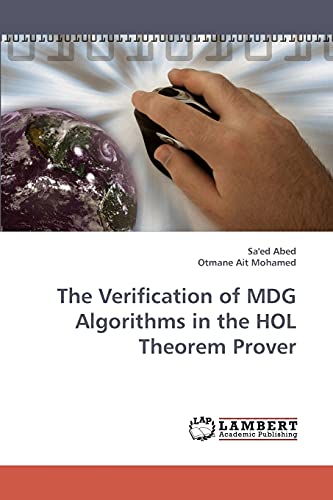
Inhaltsangabe
Formal verification of digital systems is achieved, today, using one of two main approaches: states exploration (mainly model checking (MC)) or deductive reasoning (theorem proving). The combination of the two approaches promises to overcome the limitation and to enhance the capabilities of each. Our research is motivated by this goal. In this book, we provide the necessary infrastructure (data structure + algorithms) to define high level states exploration in the HOL theorem prover named as MDG-HOL platform. We have based our approach on Multiway Decision Graphs (MDGs). We formalize the basic MDG operations within HOL following a deep embedding approach. Then, we derive the correctness proof for each MDG basic operator. Based on this platform, the MDG reachability analysis is defined in HOL as a conversion that uses the MDG theory within HOL. Finally, we propose a reduction technique to improve MDGs MC based on MDG-HOL platform. The idea is to prune the transition relation of the circuits using pre-proved theorems from the specification given at system level. We use the consistency of the specifications to verify if the reduced model is faithful to the original one.
Die Inhaltsangabe kann sich auf eine andere Ausgabe dieses Titels beziehen.
Reseña del editor
Formal verification of digital systems is achieved, today, using one of two main approaches: states exploration (mainly model checking (MC)) or deductive reasoning (theorem proving). The combination of the two approaches promises to overcome the limitation and to enhance the capabilities of each. Our research is motivated by this goal. In this book, we provide the necessary infrastructure (data structure + algorithms) to define high level states exploration in the HOL theorem prover named as MDG-HOL platform. We have based our approach on Multiway Decision Graphs (MDGs). We formalize the basic MDG operations within HOL following a deep embedding approach. Then, we derive the correctness proof for each MDG basic operator. Based on this platform, the MDG reachability analysis is defined in HOL as a conversion that uses the MDG theory within HOL. Finally, we propose a reduction technique to improve MDGs MC based on MDG-HOL platform. The idea is to prune the transition relation of the circuits using pre-proved theorems from the specification given at system level. We use the consistency of the specifications to verify if the reduced model is faithful to the original one.
Biografía del autor
Sa?ed Abed received in 94 & 96 his B.Sc. & M.Sc. in Elec. & Comp. Eng. from JUST, Jordan. In June 2008, he received his Ph.D. in Comp. Eng. from Concordia University, Canada. In 2008 Dr. Abed joined the Comp. Eng. Dep. of Hashemite University, Jordan, as an Assistant Professor. Dr. Abed?s research interests include Verification and Formal Methods.
„Über diesen Titel“ kann sich auf eine andere Ausgabe dieses Titels beziehen.
Suchergebnisse für The Verification of MDG Algorithms in the HOL Theorem...
The Verification of MDG Algorithms in the HOL Theorem Prover
Anbieter: moluna, Greven, Deutschland
Zustand: New. Artikel-Nr. 5412417
Neu kaufen
Versand von Deutschland nach USA
Anzahl: Mehr als 20 verfügbar
The Verification of MDG Algorithms in the HOL Theorem Prover
Anbieter: buchversandmimpf2000, Emtmannsberg, BAYE, Deutschland
Taschenbuch. Zustand: Neu. Neuware -Formal verification of digital systems is achieved, today, using one of two main approaches: states exploration (mainly model checking (MC)) or deductive reasoning (theorem proving). The combination of the two approaches promises to overcome the limitation and to enhance the capabilities of each. Our research is motivated by this goal. In this book, we provide the necessary infrastructure (data structure + algorithms) to define high level states exploration in the HOL theorem prover named as MDG-HOL platform. We have based our approach on Multiway Decision Graphs (MDGs). We formalize the basic MDG operations within HOL following a deep embedding approach. Then, we derive the correctness proof for each MDG basic operator. Based on this platform, the MDG reachability analysis is defined in HOL as a conversion that uses the MDG theory within HOL. Finally, we propose a reduction technique to improve MDGs MC based on MDG-HOL platform. The idea is to prune the transition relation of the circuits using pre-proved theorems from the specification given at system level. We use the consistency of the specifications to verify if the reduced model is faithful to the original one.Books on Demand GmbH, Überseering 33, 22297 Hamburg 160 pp. Englisch. Artikel-Nr. 9783838317380
Neu kaufen
Versand von Deutschland nach USA
Anzahl: 2 verfügbar
The Verification of MDG Algorithms in the HOL Theorem Prover
Anbieter: preigu, Osnabrück, Deutschland
Taschenbuch. Zustand: Neu. The Verification of MDG Algorithms in the HOL Theorem Prover | Sa''ed Abed (u. a.) | Taschenbuch | 160 S. | Englisch | 2010 | LAP LAMBERT Academic Publishing | EAN 9783838317380 | Verantwortliche Person für die EU: BoD - Books on Demand, In de Tarpen 42, 22848 Norderstedt, info[at]bod[dot]de | Anbieter: preigu. Artikel-Nr. 101468580
Neu kaufen
Versand von Deutschland nach USA
Anzahl: 5 verfügbar
